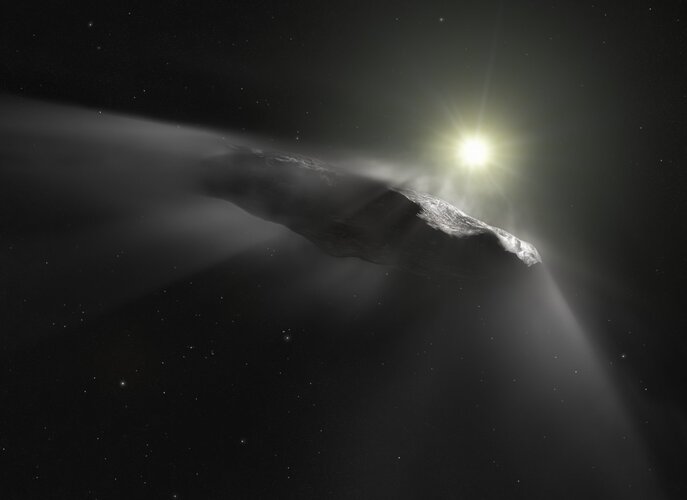NASA discovers third interstellar comet
Sunday, 06 July 2025 07:38 NASA discovered the third interstellar comet through a survey telescope in Rio Hurtado, Chile.
The interstellar comet first observed on Tuesday by NASA's Asteroid Terrestrial-impact Alert System telescope, or ATLAS, has been officially named 3I/ATLAS.
A series of "pre-discovery" observations dating back to June 14 from three ATLAS Telescopes globally and the Zwicky Transient Faci
NASA discovered the third interstellar comet through a survey telescope in Rio Hurtado, Chile.
The interstellar comet first observed on Tuesday by NASA's Asteroid Terrestrial-impact Alert System telescope, or ATLAS, has been officially named 3I/ATLAS.
A series of "pre-discovery" observations dating back to June 14 from three ATLAS Telescopes globally and the Zwicky Transient Faci Red, white and blue on the Red Planet
Sunday, 06 July 2025 07:38 On the eve of the 249th anniversary of American independence, NASA on Tuesday showcased a patriotic image of Old Glory as seen from hundreds of millions of miles away.
A plaque bearing the United States flag is on an aluminum plate at the base of the mast, or "head," of NASA's Perseverance rover on the Red Planet.
An image of the flag was taken on June 28 by the WATSON (Wide Angl
On the eve of the 249th anniversary of American independence, NASA on Tuesday showcased a patriotic image of Old Glory as seen from hundreds of millions of miles away.
A plaque bearing the United States flag is on an aluminum plate at the base of the mast, or "head," of NASA's Perseverance rover on the Red Planet.
An image of the flag was taken on June 28 by the WATSON (Wide Angl Week in images: 30 June - 4 July 2025
Friday, 04 July 2025 12:13
Week in images: 30 June - 4 July 2025
Discover our week through the lens
Boeing lands $2.8 billion deal to build next-gen nuclear communications satellites
Friday, 04 July 2025 08:03
The ESS satellites are central to U.S. nuclear command, control and communications
Earth from Space: Zanzibar, Tanzania
Friday, 04 July 2025 07:00 Image:
Earth from Space: Zanzibar, Tanzania
Image:
Earth from Space: Zanzibar, Tanzania Antarctic waters getting saltier as sea ice wanes
Friday, 04 July 2025 05:25
Using data from ESA’s SMOS satellite, scientists have revealed a surprising shift in the Southern Ocean – surface waters around Antarctica are growing saltier, even as sea ice is diminishing rapidly. This finding defies the norm because melting ice typically freshens ocean surface water.
The implications are far-reaching as changes in this remote region can disrupt global ocean currents, affect climate patterns, and alter ecosystems far beyond the Antarctic.
Congress passes budget reconciliation bill with $10 billion for NASA
Friday, 04 July 2025 01:24
Congress approved a budget reconciliation bill that includes nearly $10 billion for NASA human spaceflight programs and could also lead to the transfer of a space shuttle to Houston.
China launches first classified Shiyan-28B experimental satellite
Thursday, 03 July 2025 21:40
ESA tracks rare interstellar comet
Thursday, 03 July 2025 15:00
Astronomers have confirmed the discovery of a rare celestial visitor: a comet from beyond our Solar System.
Officially named 3I/ATLAS, this newly identified interstellar object is only the third of its kind ever observed, following the famous 1I/ʻOumuamua in 2017 and 2I/Borisov in 2019.
ESA prepares downselect for European Launcher Challenge
Thursday, 03 July 2025 14:58
The European Space Agency will soon select the finalists for a competition intended to support the development of new launch vehicles by European companies.
China launches first low-inclination orbit SAR satellite 'Haishao-1'
Thursday, 03 July 2025 12:22This request seems a bit unusual, so we need to confirm that you're human. Please press and hold the button until it turns completely green. Thank you for your cooperation!
Press and hold the button
If you believe this is an error, please contact our support team.
185.132.36.159 : a0138837-26ea-4c8c-881d-f3ec8f80
SpaceX is planning to build a new project in Florida, records say
Thursday, 03 July 2025 10:40This request seems a bit unusual, so we need to confirm that you're human. Please press and hold the button until it turns completely green. Thank you for your cooperation!
Press and hold the button
If you believe this is an error, please contact our support team.
185.132.36.159 : 5aaf59ff-c839-4c43-85c9-82a77cbe
Overnight Canaveral launch marked 500th for SpaceX Falcon 9
Thursday, 03 July 2025 10:34This request seems a bit unusual, so we need to confirm that you're human. Please press and hold the button until it turns completely green. Thank you for your cooperation!
Press and hold the button
If you believe this is an error, please contact our support team.
185.132.36.159 : d1de3779-1ad0-4c72-ad82-4c8b9e47
Growing evidence for evolving Dark Energy could inspire a new model of the Universe
Thursday, 03 July 2025 10:23 he birth, growth and future of our Universe are eternally fascinating.
In the last decades, telescopes have been able to observe the skies with unprecedented precision and sensitivity.
Our research team on the South Pole Telescope is studying how the Universe evolved and has changed over time. We have just released two years' worth of mapping of the infant universe over 1/25th of the
he birth, growth and future of our Universe are eternally fascinating.
In the last decades, telescopes have been able to observe the skies with unprecedented precision and sensitivity.
Our research team on the South Pole Telescope is studying how the Universe evolved and has changed over time. We have just released two years' worth of mapping of the infant universe over 1/25th of the 

